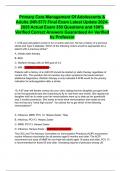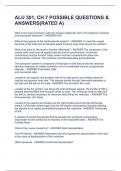Primary Care Management Of Adolescents &
Adults (NR-577) Final Exam Latest Update 2024-
2025 Actual Exam 350 Questions and 100%
Verified Correct Answers Guaranteed A+ Verified
by Professor
1. A 56-year-old patient comes in for a routine well visit. He has a history of a previous
stroke and Type 2 Diabetes. Which of the following orders would be appropriate for a
patient with a previous stroke?
A. Initiate statin therapy
B. EEG
C. Warfarin therapy with an INR goal of 2-3
D. MRI - CORRECT ANSWER: A.
Patients with a history of an ASCVD should be started on statin therapy regardless of
current LDL. The question did not mention any other symptoms that would warrant
additional diagnostics. Warfarin therapy is only indicated if AFIB would be the primary
indication for anticoagulation after a stroke.
10. A 67-year-old female comes into your clinic stating that her daughter just gave birth
to her first grandchild and she if planning to fly to visit them next month. She reports her
daughter told her to make sure her immunizations were up to date as her grandchild
was 2 months premature. She wants to know what immunizations she needs as she
has not had any "since high school". You advise her to get which of the following
immunizations?
A. Influenza, MMR, PCV 13, Herpes Zoster, Tdap
B. Influenza, PCV13, Herpes Zoster
C. MMR, PCV13, Herpes Zoster
D. Influenza, Herpes Zoster - CORRECT ANSWER: A.
The CDC and The Advisory Committee on Immunization Practices (ACIP) recommend
routine influenza vaccination for all persons aged 6 months and older. The ACIP
recommend one dose of MMR for non-high-risk adults aged 18 years and older. PCV 13
is recommended for those 65 and older. Increasing reports of pertussis among US
,adolescents, adults, and their infant contacts have stimulated vaccine development for
older age groups. The ACIP recommends Tdap for those age 65 years and older who
are around at-risk infants such as those with prematurity. The ACIP also recommends
Herpes Zoster vaccination at age 50.
100. A 4-year-old presents to your clinic today in need of vaccines before starting pre-
school. She is currently up to date on all of her other vaccines prior to this visit. What
vaccines will she receive today?
a) Hep A, Hib, IPV, DTaP
b) DTaP, IPV, MMR, VAR
c) Tdap, MMR, VAR, IPV
d) DTaP, MMR, VAR, Hib - CORRECT ANSWER: B.
101. In differentiating between acute epididymitis and testicular torsion, which key
finding on physical exam should you expect to see with acute epididymitis versus
testicular torsion?
A. Positive Prehn's sign
B. Swelling of the effected testicle
C. Irritative voiding symptoms
D. Unilateral groin pain - CORRECT ANSWER: A.
Elevating the scrotum in acute epididymitis alleviates pain, whereas in testicular torsion
there is no difference in pain quality. Swelling and unilateral groin pain will be present in
both conditions. Irritative voiding symptoms will occur with acute epididymitis than
testicular torsion
102. You are seeing a patient in the clinic who states he has tried for over a year with
his fiancé to conceive. His fiancé has a child from a previous relationship. When
reviewing medical history, a history of _____ in adolescence would help to pinpoint a
possible cause of infertility?
A. Chickenpox
B. Wilson's disease
C. Mumps
D. Mononucleosis - CORRECT ANSWER: C.
,In reviewing the history, an infection of mumps orchitis impairs fertility in 13% of patients
(Defendi, 2019). The other illnesses do not impair fertility.
103. A 30-year old female is being seen in your office utilizing sliding scale self-pay for
monitoring of her INR on chronic Coumadin therapy for an artificial valve. She states
she had a positive pregnancy test and her last menstrual period was 8 weeks prior. She
denies cramping or bleeding. The next course of action is to:
A. Discontinue Coumadin and begin on a DOAC
B. Refer the patient to cardiology for management
C. Obtain a PT/INR and ensure dosage of Coumadin is at or below 5mg/daily
D. Discontinue Coumadin and avoid blood thinners during the pregnancy - CORRECT
ANSWER: C.
Coumadin in the first trimester is safe at dosages of 5mg/day or less (McPhee &
Papadakis, 2018). The risks of stopping Coumadin is greater for the mother than the
developing fetus, so discontinuing the medicine would not be appropriate. The patient
does not have insurance, so referring to cardiology would be an expense the patient
would not be able to afford. DOACs are not recommended for mechanical valve
replacements since there is no data to support its use in pregnancy.
104 A 16-year-old female presents to the clinic stating she has noticed a mass in her
right breast. On examination, the mass is 2cm, mobile, rubbery, and nontender, located
in the upper, outer quadrant in the 10 o'clock position. Fibroadenoma is suspected.
What is the next step?
a. Observation
b. Surgical excision
c. Ultrasound
d. Biopsy - CORRECT ANSWER: A.
Fibroadenoma is common in adolescent girls. Diagnosed on examination with findings
of nontender, smooth, rubbery, well-circumscribed, and mobile. Management is
observation. Fibroadenomas less than 5cm should be monitored over 3-4 months for
growth or regression, then semiannually for a few years, and then for regressing
fibroadenomas yearly. Referral to breast specialist should be made if larger than 5cm,
enlarging, skin changes in overlying skin, or previous malignancy.
, 105. A 15-year-old female is brought into the clinic by her mother. The mother is
concerned she has not started her period. Secondary sex characteristics are present,
but no history of menses. Patient denies being sexually active. Patient has not had any
recent illness and has no PMH. All of the following laboratory test would be warranted
except?
a. Urine pregnancy test
b. CBC
c. CMP
d. TSH, Prolactin, and FSH. - CORRECT ANSWER: C.
Primary amenorrhea- no menses or secondary sex characteristics by 13y, or no menses
or secondary sex characteristics by 15y. Page 125 Figure 4-6 provides a guide to
laboratory and radiologic evaluation. Initial studies should include pregnancy test, CBC,
TSH, Prolactin, and FSH.
106. A 28 year old female presents to the office with a tender lump in her left breast,
approximately 1cm. She noticed the lump right before she began her menstrual cycle 2
months ago. She thought it was going away, but symptoms returned few days ago
before she started her menstrual cycle, again.
Which of the following diagnostic test would you order to for the initial evaluation of the
breast lump?
A. Core needle Biopsy
B. Ultrasonography
C. Excisional Biopsy
D. Mammography - CORRECT ANSWER: B.
Core needle biopsy is preferred over Fine needle biopsy, but not for initial evaluation of
a suspected fibrocystic condition. Ultrasonography and mammography are the preferred
initial diagnostic test for suspected fibrocystic condition. An ultrasound should be
ordered if less than 30 years of age and a mammogram if greater than 30 years of age.
An excisional biopsy is often not required for this condition.





